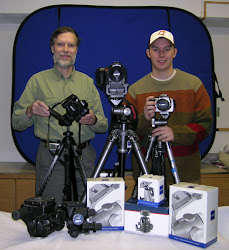If you search Google for "rule of thirds," you will get more than 3 million returns. Clearly it is a popular rule and deserves to be looked at closely. I examined about 50 of these websites and found them all to accept the premise that using the rule of thirds is a key to producing good photographs, although a few suggested that the rule should be viewed more as a guide.
The following comments were typical:
"A handy rule to follow that will help you to compose a quality photo every time is the rule of thirds."
"Everything you see in a frame needs to be composed along the lines of the rule of thirds."
"Using the Rule of Thirds helps produce nicely balanced easy on the eye pictures."
This advice is usually followed by a diagram showing how the rule of thirds is calculated. A small number of the sites go on to say that the rule of thirds was derived from the Golden Mean. Some even give a brief history of the Golden Mean. At least one writer justifies the use of the rule of thirds based on eye-scan studies.
What is the rule of thirds? It is a guide for positioning the center of interest in a photograph. According to this rule, there are four preferred points to place a center of interest. To find these points, draw imaginary parallel lines across your camera's viewfinder at the one-third and two-thirds positions. Do this in both the horizontal and vertical directions. These four lines will meet at four points. The points mark where the center of interest should be placed.
As I said, many sites make the claim that the rule of thirds is derived from the Golden Mean. And what is the Golden Mean (see also: Golden Cup, Golden Triangle, Golden Rectangle, Golden Ratio, Golden Spiral, all based on approximately the same idea). The Golden Mean is a ratio of two numbers (approximately 1:.62). It can be represented by a line that is divided so that the shorter segment is about .38 and the longer about .62 of the length. A golden rectangle is a rectangle whose sides have the ratio of 1:.62. In Diagram 2 the entire figure is a Golden Rectangle. By dividing the large rectangle at the .618 position, we get a square and another Golden rectangle.
As there are many mathematic sites that give the history and the derivation of the Golden Mean, there is no reason to repeat that information here. I haven't found any sites that give the history of the rule of thirds. It is always referred to as a simplification of the Golden Mean or Golden Rectangle.
But is it? Not exactly. First, the rule of thirds uses lines placed at the 33% and 67% positions, whereas the Golden Mean places its line at 62%. So already we're 5% off. That's not too bad. But there is another problem. The rule of thirds is about points, the four points where the parallel lines meet. The Golden Mean is about a line. Points and lines are not the same thing.
There is another problem. The ratio of the sides of the Golden Rectangle is approximately 3:2, or about the same as the sides of a 35mm negative. But the ratio of the sides of most consumer digital cameras is 4:3. Not only that, but prints often have a different height-to-width ratio (aspect) so your perfectly composed photograph is cropped when it is printed.
But if it works, forget all about these arguments. The most important thing is to get superior photographs. So the next question is, "Does it work?"
Eye-tracking studies. There have been a number of scientific studies, many ongoing, to determine how a viewer's eyes move when he looks at a piece of art. The early results show that there is no universal eye-scan pattern. It depends, in part, on what the viewer is looking for and his level of expertise.
Do viewers really prefer paintings and photographs that use the rule of thirds? I am not aware of any studies done on the rule of thirds, but there have been quite a few on the Golden Rectangle.
The first of many objectives studies was done in the 1870s by the German psychologist G. T. Fechner. He presented his subjects with a set of ten rectangles of varied proportions and asked them to choose the one they found most pleasing. Although the Golden Rectangle was the favorite, it was chosen by only 35% of the subjects. The second favorite, a rectangle with a 1:1.5 ratio, was picked by 21% of the subjects.
Studies on rectangular preference have continued to the present with mixed results. Some researchers have found a preference for the Golden Mean while others have not. However, in those studies where a preference was found, it was never higher than 35%.
In 1894 the American psychologist Edgar Pierce did another interesting experiment. He asked people to place a line in a frame in the position they found most pleasing. The Golden Ratio was the most popular position. However, when Pierce placed additional lines on both sides of the moveable line, the subjects tended to move their line from the Golden Mean position to a position about half-way between the closest fixed lines.
Conclusion. First of all, for reasons pointed out above, the rule of thirds and the Golden Rectangle are not the same thing. One deals with points and the other deals with lines. Second, objective studies show that although there probably is a preference for art based on Golden Rectangle proportions, at best it is only preferred by 35% of viewers. Finally, the studies done by Pierce showed that subjects initially showed a preference for a line placed at about the 60% position in the frame. However, they changed their preference when additional lines were put into the frame. Since the rule of thirds doesn't take into consideration anything but placement of the center of interest, perhaps it's too simple a concept to be used in composing complex photographs.
Edward Ginsberg is currently writing a book to help the beginning photographer find true happiness as he embarks on the road to creativity. Ed's photos can be seen on his website, http://www.line17.com, where he also offers a free tutorial.
Other Sites : Cheap Handbags4u







0 comments:
Post a Comment